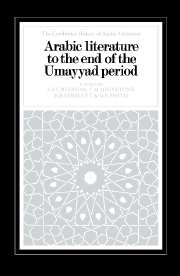Book contents
- Frontmatter
- Contents
- Editorial introduction
- 1 The tribes of pre-Islamic Arabia
- 2 The Umayyad Empire, c. A.D. 750
- 1 Background topics
- 2 Pre-Islamic poetry
- 3 Early Arabic prose
- 4 The beginnings of Arabic prose literature: the epistolary genre
- 5 The role of parallelism in Arabic prose
- 6 The Qur'ān-I
- 7 The Qur'ān–II
- 8 Qiṣaṣ elements in the Qur'ān
- 9 Aspects of the Qur'ān today
- 10 Ḥadīth literature–I: The development of the science of Ḥadīth
- 11 Ḥadīth literature-II: Collection and transmission of Ḥadīth
- 12 Shī'ī Ḥadīth
- 13 Narrative elements in the Ḥadīth literature
- 14 European criticism of Ḥadīth literature
- 15 The impact of the Qur'ān and Ḥadīth on medieval Arabic literature
- 16 The Maghāzī literature
- 17 The Sīrah literature
- 18 The poetry of the Sīrah literature
- 19 Fables and legends in pre-Islamic and early Islamic times
- 20 Umayyad poetry
- 21 Music and verse
- 22 The Greek impact on Arabic literature
- 23 The Persian impact on Arabic literature
- 24 The Syrian impact on Arabic literature
- Appendix Bibliography of translations of the Qur'ān into European languages
- Glossary
- List of sources
- Index
7 - The Qur'ān–II
Published online by Cambridge University Press: 28 May 2012
- Frontmatter
- Contents
- Editorial introduction
- 1 The tribes of pre-Islamic Arabia
- 2 The Umayyad Empire, c. A.D. 750
- 1 Background topics
- 2 Pre-Islamic poetry
- 3 Early Arabic prose
- 4 The beginnings of Arabic prose literature: the epistolary genre
- 5 The role of parallelism in Arabic prose
- 6 The Qur'ān-I
- 7 The Qur'ān–II
- 8 Qiṣaṣ elements in the Qur'ān
- 9 Aspects of the Qur'ān today
- 10 Ḥadīth literature–I: The development of the science of Ḥadīth
- 11 Ḥadīth literature-II: Collection and transmission of Ḥadīth
- 12 Shī'ī Ḥadīth
- 13 Narrative elements in the Ḥadīth literature
- 14 European criticism of Ḥadīth literature
- 15 The impact of the Qur'ān and Ḥadīth on medieval Arabic literature
- 16 The Maghāzī literature
- 17 The Sīrah literature
- 18 The poetry of the Sīrah literature
- 19 Fables and legends in pre-Islamic and early Islamic times
- 20 Umayyad poetry
- 21 Music and verse
- 22 The Greek impact on Arabic literature
- 23 The Persian impact on Arabic literature
- 24 The Syrian impact on Arabic literature
- Appendix Bibliography of translations of the Qur'ān into European languages
- Glossary
- List of sources
- Index
Summary
DEVELOPMENT OF MUḤAMMAD'S MESSAGE
The chronology of the material contained in the Qur'ān on which any attempt to follow the development of Muhammad's teaching must rest, has been the subject of intense study both by Muslim scholars and by orientalists. Yet it cannot be said their studies take us very far. The main obstacles are formidable: the largely composite nature of the sūrahs the neutral order of the sūrahs in the textus receptus; and the relative lack of distinct reference to events for which there is reasonably firm evidence elsewhere.
Muslim studies of the chronology centre on the reasons for revelations, the asbāb al-nuzūl. Wherever reasons for a revelation were thought to exist, they were treated not only in the Sīrah, Ḥadīth and Tafsīr, but also in specialized works dealing only with the asbāb al-nuzūl. Muslim scholars were aware of, but did not follow up, other criteria, such as those of style. It was noted, for example, that the earliest sūrahs had short verses and that the length of the verses tended to increase as time went on. On a more detailed level, the use of the phrase “O people”, mainly a Meccan usage, was contrasted with that of “O you who believe”, used only at Medina.
Judgement based on the asbāb al-nuzūl is a useful approach, for proper identification of a passage with something external provides the only sound evidence for dating it. Weakness lay in execution rather than in method.
- Type
- Chapter
- Information
- Arabic Literature to the End of the Umayyad Period , pp. 228 - 245Publisher: Cambridge University PressPrint publication year: 1983



